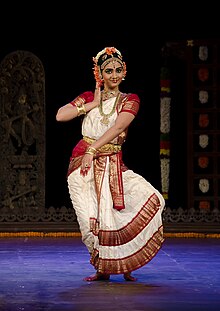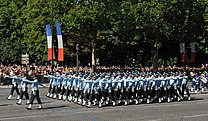User:Fowler&fowler/background color
A Chital (Axis axis) stag attempts to browse in the Nagarhole National Park in a region covered by a moderately dense forest.
A Chital (Axis axis) stag attempts to browse in the Nagarhole National Park in a region covered by a moderately dense forest.
A Chital (Axis axis) stag attempts to browse in the Nagarhole National Park in a region covered by a moderately dense forest.

Prime Minister Narendra Modi of India (left, background) in talks with President Enrique Peña Nieto of Mexico during the former's visit to Mexico, June 2016

(Top) A pre-14th century CE manuscript of the Rigveda, which was composed from 1500 BCE to 1200 BCE and subsequently orally transmitted. (Bottom) The "Battle at Lanka," a scene from the Sanskrit epic Ramayana—composed between 700 BCE and 200 CE—was illustrated by Sahibdin, an artist of the 17th century.
(Top) A pre-14th century CE manuscript of the Rigveda, which was composed from 1500 BCE to 1200 BCE and subsequently orally transmitted. (Bottom) The "Battle at Lanka," a scene from the Sanskrit epic Ramayana—composed between 700 BCE and 200 CE—was illustrated by Sahibdin, an artist of the 17th century.
During the 1950s and 60s, India played a pivotal role in the Non-Aligned Movement.[1] From left to right: Gamal Abdel Nasser of United Arab Republic (now Egypt), Josip Broz Tito of Yugoslavia and Jawaharlal Nehru in Belgrade, September 1961.

Flowing near Hampi is the Tungabhadra river, a tributary of the peninsular Krishna river, which empties into the Bay of Bengal. The circular shape of the coracle makes it stable in rivers with rocky outcrops.[2]
Flowing near Hampi is the Tungabhadra river, a tributary of the peninsular Krishna river, which empties into the Bay of Bengal. The circular shape of the coracle makes it stable in rivers with rocky outcrops.[2]

The Indian Air Force contingent marching at the 221st Bastille Day military parade in Paris, on 14 July 2009. The parade at which India was the foreign guest was led by the India's oldest regiment, the Maratha Light Infantry, founded in 1768.[3]

India's National Academy of Performance Arts has recognized eight Indian dance styles to be classical. One such is Kuchipudi shown here.

- ^ a b Dinkel, Jürgen (3 December 2018). The Non-Aligned Movement: Genesis, Organization and Politics (1927–1992). BRILL. pp. 92–93. ISBN 978-90-04-33613-1.
- ^ a b Mcgrail, Sean; Blue, Lucy; Kentley, Eric (2003), Boats of South Asia, Routledge, p. 257, ISBN 978-1-134-43130-4
- ^ a b Muir, Hugh (13 July 2009), Diary, The Guardian Quote: "Members of the Indian armed forces have the plum job of leading off the great morning parade for Bastille Day. Only after units and bands from India's navy and air force have followed the Maratha Light Infantry will the parade be entirely given over to ... France's armed services."









